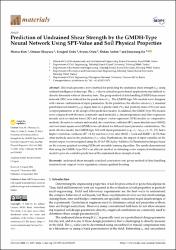| dc.contributor.author | Kim, Mintae | |
| dc.contributor.author | Okuyucu, Osman | |
| dc.contributor.author | Ordu, Ertuğrul | |
| dc.contributor.author | Ordu, Şeyma | |
| dc.contributor.author | Arslan, Özkan | |
| dc.contributor.author | Ko, Junyoung | |
| dc.date.accessioned | 2023-04-20T08:01:15Z | |
| dc.date.available | 2023-04-20T08:01:15Z | |
| dc.date.issued | 2022 | |
| dc.identifier.issn | 1996-1944 | |
| dc.identifier.uri | https://doi.org/10.3390/ma15186385 | |
| dc.identifier.uri | https://hdl.handle.net/20.500.11776/10826 | |
| dc.description.abstract | This study presents a novel method for predicting the undrained shear strength (c(u)) using artificial intelligence technology. The c(u) value is critical in geotechnical applications and difficult to directly determine without laboratory tests. The group method of data handling (GMDH)-type neural network (NN) was utilized for the prediction of c(u). The GMDH-type NN models were designed with various combinations of input parameters. In the prediction, the effective stress (sigma(v)'), standard penetration test result (N-SPT), liquid limit (LL), plastic limit (PL), and plasticity index (PI) were used as input parameters in the design of the prediction models. In addition, the GMDH-type NN models were compared with the most commonly used method (i.e., linear regression) and other regression models such as random forest (RF) and support vector regression (SVR) models as comparative methods. In order to evaluate each model, the correlation coefficient (R-2), mean absolute error (MAE), and root mean square error (RMSE) were calculated for different input parameter combinations. The most effective model, the GMDH-type NN with input parameters (e.g., sigma(v)', N-SPT, LL, PL, PI), had a higher correlation coefficient (R-2 = 0.83) and lower error rates (MAE = 14.64 and RMSE = 22.74) than other methods used in the prediction of c(u) value. Furthermore, the impact of input variables on the model output was investigated using the SHAP (SHApley Additive ExPlanations) technique based on the extreme gradient boosting (XGBoost) ensemble learning algorithm. The results demonstrated that using the GMDH-type NN is an efficient method in obtaining a new empirical mathematical model to provide a reliable prediction of the undrained shear strength of soils. | en_US |
| dc.description.sponsorship | Chungnam National University; National Research Foundation of Korea (NRF) - Korea government (MSIT) [NRF2022R1C1C1011477] | en_US |
| dc.description.sponsorship | This work was supported by research fund of Chungnam National University and National Research Foundation of Korea (NRF) grant funded by the Korea government (MSIT) (No. NRF2022R1C1C1011477). | en_US |
| dc.language.iso | eng | en_US |
| dc.publisher | MDPI | en_US |
| dc.identifier.doi | 10.3390/ma15186385 | |
| dc.rights | info:eu-repo/semantics/openAccess | en_US |
| dc.subject | Undrained Shear Strength | en_US |
| dc.subject | Standard Penetration Test | en_US |
| dc.subject | Group Method Of Data Handling | en_US |
| dc.subject | Random Forest | en_US |
| dc.subject | Support Vector Regression | en_US |
| dc.subject | Extreme Gradient Boosting | en_US |
| dc.subject | Fine-Grained Soils | en_US |
| dc.subject | Random Forest | en_US |
| dc.subject | Regression | en_US |
| dc.subject | Models | en_US |
| dc.subject | Trees | en_US |
| dc.title | Prediction of Undrained Shear Strength by the GMDH-Type Neural Network Using SPT-Value and Soil Physical Properties | en_US |
| dc.type | article | en_US |
| dc.relation.ispartof | Materials | en_US |
| dc.department | Fakülteler, Çorlu Mühendislik Fakültesi, Elektronik ve Haberleşme Mühendisliği Bölümü | en_US |
| dc.identifier.volume | 15 | en_US |
| dc.identifier.issue | 18 | en_US |
| dc.institutionauthor | Okuyucu, Osman | |
| dc.institutionauthor | Ordu, Ertuğrul | |
| dc.institutionauthor | Ordu, Şeyma | |
| dc.institutionauthor | Arslan, Özkan | |
| dc.relation.publicationcategory | Makale - Uluslararası Hakemli Dergi - Kurum Öğretim Elemanı | en_US |
| dc.authorscopusid | 56754342900 | |
| dc.authorscopusid | 57209331250 | |
| dc.authorscopusid | 57907081600 | |
| dc.authorscopusid | 26325060700 | |
| dc.authorscopusid | 57203165669 | |
| dc.authorscopusid | 55764279800 | |
| dc.identifier.wos | WOS:000856875300001 | en_US |
| dc.identifier.scopus | 2-s2.0-85138797306 | en_US |
| dc.identifier.pmid | 36143696 | en_US |



















